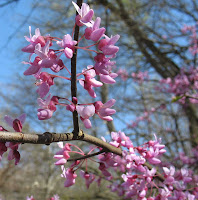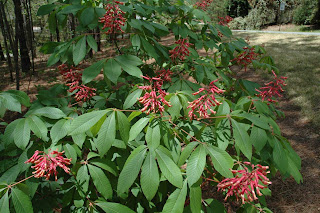I am not sure why it took me so long to try making pasta. I grew up eating only homemade pasta. Every few weeks my father would bust out the pasta machine, roll out long strips of dough and turn flour into a meal. But I have never made pasta at home. I think my hesitance to make pasta at home is because I thought I had to have a pasta maker. I felt that some heavy, silvery set of gears that can be vice gripped to the counter top was integral to the process of making pasta. And indeed it is, for some people. But I have no room for bulky machinery. I barely even use my stand mixer because I don't have enough counter space to keep it out, it must stay locked away in the pantry. Then I read this interesting blog post. And I suddenly realized that one could make pasta at home without another piece of one use wonder equipment! Life has opened up to me!
I quickly emailed my father for his recipe. He said he started with 2 cups of flour and four eggs and about a tablespoon of olive oil. So I started there, with a trusted family recipe. Only I made some slight alterations--because you wouldn't expect anything less from me! No really, it is not that bad this time. I just made it different by using whole wheat flour, something my dad never does. I used 100% white whole wheat flour. I remember watching Mario Batali making pasta, and he always made the flour into a pile, and carved out a well. I cracked my eggs in, one, two and three--whoops! My third egg spilled over the wall of my well an all over my counter. Eggs look so solid when they are cracked into a bowl. But they run like water when they have nothing to contain them. Rats! I scooped the egg back into the messy flour. The recipe called for 4 eggs. But I figured that 3 eggs would just make a slightly smaller batch. Plus I was using extra large eggs. I hate that everything seems bigger than natural in the US (even though I love my country--have I mentioned that?). I never trust foods in bigger forms. But recently I discovered that my recipes were just coming out better when I used extra large eggs. I don't know why, but it works on everything from muffins to custards.
We didn't eat them right away. We had other wheat dinners and I have this thing about not eating pasta too often. I try to space it out over the course of a week. And I don't think we have ever had pasta more than twice in one week. Not because I am bragging about that. I am a little nuts about the wheat and grains. But I have to explain why I didn't have this post up sooner! Last week it was imperative that I make my friend D a lasagna because she had a baby. Yay! Congrats! And if you are going to the trouble to make one lasagna, you really ought to make two. So we had already made pasta for dinner on Monday, plus leftovers. It was Friday before I was read to have pasta again. And even that I felt like was too many nights eating pasta for dinner. But I took one for the team.
I usually have some frozen spaghetti sauce put up for a weeknight meal. So I brought out my last batch and took out my homemade pasta. It was ugly stuff. A week of drying out in the fridge took it's toll on my precious strippy strips. Then it hit me. I had no idea how much pasta I had made. I usually buy 12 oz boxes of pasta and I know my family will eat about 8-9 ounces, so not quite one package, two-thirds if I don't want any leftovers. But here I had this ziploc bag of homemade pasta, how much should I make??
I brought out the old Weight Watchers scale and laid a plate on top. I measured out 9 ounces of pasta. Judging by what was left I think I made about 11 or 12 ounces of pasta. 9 ounces didn't look like enough. But scales don't lie.
For next time: I will use a little more olive oil to give the dough some conditioning. I will also try and roll the sheets a little thinner before cutting the strips. That's easier said than done because rolling out the sheets was, like I mentioned, like doing upper body work at the gym, but one must strive for perfection. I will also cut the strips thinner. Because if I can only make the sheets so thin with a rolling pin, I can reduce necessary cooking time by making say, linguine rather than fettuccine or tagliatelle. I don't even know what I did. Some of my strips were tagliatelle, some were like lasagna noodles (just kidding).
I will also try and make this pasta in larger batches. No joke, it was quick. It took me about 45 minutes from when the first pile of flour hit the counter to when I was cleaned up and the noodles were drying. But I don't really want to have to do that every week. Once a month would be more doable on my schedule. Maybe this will be a good opportunity to commit to eating pasta less? I like that my pasta has many eggs in it. So it is higher in protein than the store bought stuff. But it is still a grain based meal, very filling and lower in protein. While we ate alot of pasta last week, we usually have it only once a week. Perhaps now I could try and get down to once every other week? It is a thought. I am not opposed to grains in a general sense. But while I know that they have their place in my diet (I really do feel better and more energetic when I eat some every day), grains like to take over. They can be addictive. I have to keep them in their place, so to speak.
And finally, let me say that I am proud of this experience. While we are getting really comfortable finding what 'real food' options work for us on a busy working parent schedule, I love challenging one more convenience food. I can now take flour and eggs and turn it into pasta. Take THAT food industry. That's one more thing I don't need you for!
This Post is a part of Real Food Wednesdays at Kelly the Kitchen Kop!








